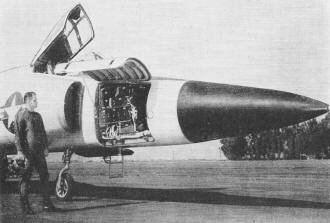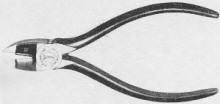Airborne Digital Computer |
||
Each month Radio & TV News magazine contained a section entitled, "What's New in Radio," which reported on some of the latest happenings in the fields of commercial, military, space, transportation, broadcast, and all other forms of wireless communications. This 1958 issue show the world's first volume production airborne digital computer, designed by Hughes Aircraft Company, installed in the nose of a U.S. Air Force F-102A Delta Dagger fighter jet (built by Convair). The 456th Fighter Interceptor Squadron website has a lot of information about the Hughes MA-1 Digitair computer and its integration with airborne radar to create a flight control system that could guide aircraft to a target for ordinance (bombs, missiles) deployment. Other topics included a wideband oscilloscope from Electronic Industries (EIC) that handled a whopping 5 MHz. It came in kit form for hobbyists and low budget commercial shops. RCA announced a new pair of pnp and npn transistors with gains into the shortwave bands. What's New in Radio Shown here is the prototype test model of the first airborne digital computer in actual production. The unit, called the Digitair, was announced recently by Hughes Aircraft Co. It is shown installed in an F-102A Air Force all-weather interceptor. The computer is small enough to fit into a 21-inch table model television cabinet.
Electronic Industries, State Road, Patterson, N. Y., one of the newest firms in the rapidly expanding kit field, has recently introduced a wide-band, high-sensitivity 5-inch oscilloscope kit which has been especially designed for' laboratory and television servicing applications. The Model 535 has a 10 mv r.m.s./ cm. sensitivity from d.c. to 5 mc., an electronically regulated power supply, and push-pull circuitry throughout. Built-in continuously variable calibrating voltages of 100, 10, 1, and 0.1 volt peak-to-peak at an accuracy of 3% are provided. The scope is housed in a blue hammertone finished cabinet with a photo-etched anodized panel. The unit measures 12"x16"x18½" and weighs slightly less than 40 pounds. It will operate on 105 to 125 volts, 50/60 cycle a.c. It draws 150 watts.
New Oblique Plier
High Frequency Transistors The Semiconductor Division of Radio Corporation of America, Somerville, N. J., has introduced a new germanium p-n-p alloy-type transistor (2N274) embodying the "drift" principle and a junction transistor of the germanium p-n-p alloy type, the 2N404. The compact design of the 2N274 opens new applications in military and commercial equipment where space is limited. It operates at frequencies extending from the standard AM band well up into the short-wave bands. The 2N404 is designed for use in switching circuits of compact, medium-speed military and industrial electronic computers. It has flexible leads and is hermetically sealed in a metal case which is 0.360" in diameter with a body length of 0.25". Leads are spaced to con-form to EIA (formerly RETMA) standards for automation requirements.
Posted January 28, 2020 |
||



